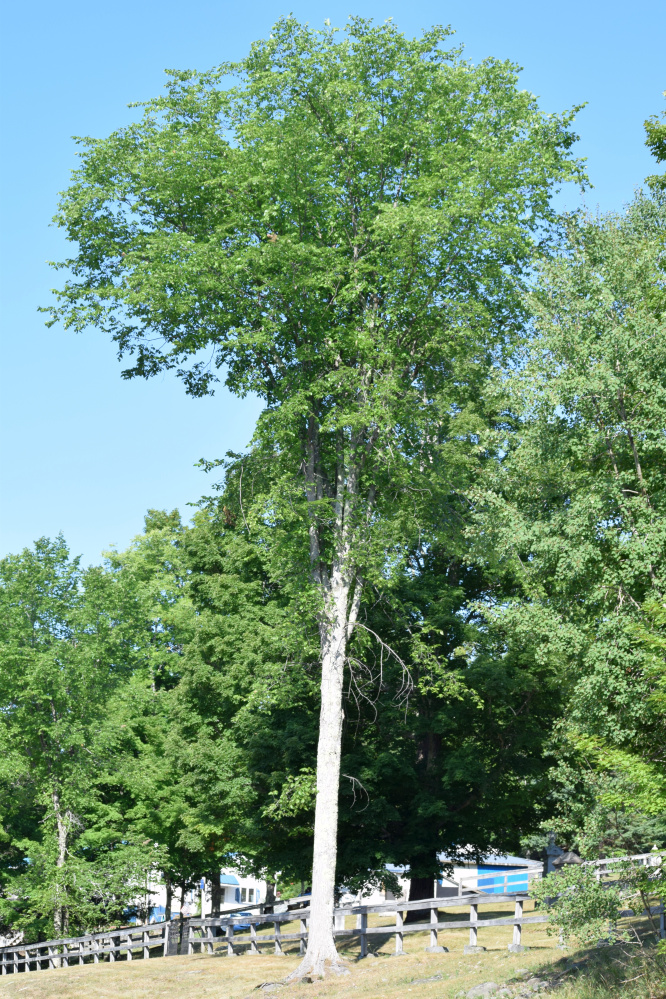When we moved to our house in the Troy woods 20-plus years ago, an elm tree was growing beside the garage. It was maybe 25 feet high, and since elms can get to 100 or even 200 feet over a full lifespan of 175 to 200, even 300 years, it was probably not an old tree. It was nice to have a survivor around.
One summer five or six years later, it died. I hadn’t paid any more attention to it than to the great red maple across the driveway, and I didn’t notice, or even know any signs of doom to watch for. It was as if the tree suddenly had a heart attack one day.
By now everybody who has even a glancing familiarity with Maine’s arboreal history knows what’s coming: This tree had Dutch elm disease, as an indigenous woodsman who came to raze the corpse pointed out.
Sometime in the 1920s, the spores of a fungus from Asia journeyed from Europe to North America on shipments of unpeeled logs. These spores stick to the bodies of bark beetles — both European and American — who bore tunnels into a tree’s inner bark and lay eggs. When the beetle eggs hatch out, the larvae feed on the tree’s bark layers. The feeding by larvae, as well as adults, can itself do serious damage to an elm tree; but meanwhile, the spores of the Ophiostoma ulmi fungus (formerly called Ceratocystis ulmi) and a recently distinguished more aggressive strain, O. nova-ulmi, stick to the beetles’ bodies. When the adult beetles fly off to new elm tree hosts, they bring the spores along with them. The spores get into the incisions the bugs make to eat the wood, and the fungus infects the tree’s vascular system, blocking water-conducting vessels. The tree starts to yellow in the leaves and wilt in the stems and eventually whole branches.
If the infection occurs early in spring, a small tree can die the same summer, which I guess is what happened to the tree by our garage.
Dutch scientists first investigated the disease in the 1920s (hence “Dutch” elm disease), and in the U.S., dying elms were first noticed in Cleveland in 1930. The beetles spread the fungus spores, and by the 1950s elm trees were dying by the hundreds of thousands. By the 1980s, according to the USDA, something like 77 million American elms had been killed.
Elm trees got wiped out along entire streets in cities all over North America, including Portland. I remember as a kid being reminded numerous times by adults that the Forest City looked nothing like what it had just 20 years earlier. Which to me might as well have been the Bronze Age — about 6,000 years ago when, it turns out, there was another dip in elm tree population, possibly disease-related as well.
American chestnut trees suffered from a similar fungal disease in the 19th and 20th centuries, and by the 1950s virtually all mature American chestnuts had died of it, according to one paper. And butternut, or white walnut, trees were similarly devastated from a slower-working fungal infection that was first noticed in the late 1960s. The U.S. Forest Service estimates that by 1995, 77 percent of the butternuts in the Southeast had died.
But, folk generalities notwithstanding, elms have not totally vanished. The biologists estimate that 1 in 100,000 elms has a natural resistance to the disease, which is considerably worse than the human survival rate for Captain Trips in Stephen King’s “The Stand.” Although it’s being studied, the biochemistry of the resistance is still not known.
You can spot American elms (Ulmus americana) here and there just driving along rural Maine roads — both live and dead. They usually have a distinct vase shape, often with twigs of leaves dangling demurely off their trunks. Beautiful trees, and you can see why city arborists liked them. Slippery elms (Ulmus rubra), which have been noted historically only in southwestern Maine, are also susceptible to the disease, which is still around. In 2010, the 217-year-old American elm known as Herbie, in Yarmouth — the largest U. americana in New England at the time, apparently, at 110 feet tall and 94 inches across the widest point of its trunk — had to be cut down because it was dying of Dutch elm disease.
Some Northeastern Indians, according to anthropologist Frank Speck, used to steep the bark of American elm in water and make tea to soothe the throat during coughs and colds, and among the Penobscots, to help alleviate bleeding in the lungs. Slippery elm bark apparently has been more widely used in decoctions for coughs, colds and digestive ailments, and is FDA-approved for use in throat lozenges, according to my Peterson guidebook.
Anyway, no elms are left in our backyard. But there are several nearby in both directions along the Bangor Road. Grace persists.
Dana Wilde lives in Troy. His new collection of naturalist essays, “Summer to Fall,” is available from North Country Press www.northcountrypress.com/summer-to-fall.html. You can contact him at naturalist1@dwildepress.net. Backyard Naturalist appears the second and fourth Thursdays each month.
Send questions/comments to the editors.




Comments are no longer available on this story